seats KIA Magnetis 2006 2.G Owner's Manual
[x] Cancel search | Manufacturer: KIA, Model Year: 2006, Model line: Magnetis, Model: KIA Magnetis 2006 2.GPages: 225, PDF Size: 3.77 MB
Page 10 of 225
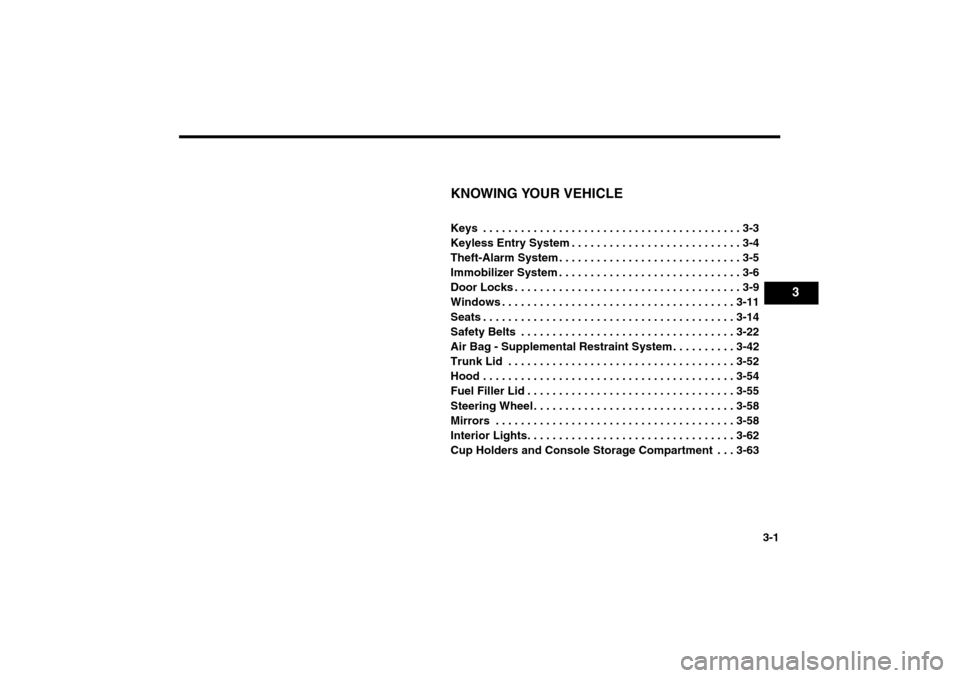
3-1
KNOWING YOUR VEHICLEKeys . . . . . . . . . . . . . . . . . . . . . . . . . . . . . . . . . . . . . . . . . 3-3
Keyless Entry System . . . . . . . . . . . . . . . . . . . . . . . . . . . 3-4
Theft-Alarm System . . . . . . . . . . . . . . . . . . . . . . . . . . . . . 3-5
Immobilizer System . . . . . . . . . . . . . . . . . . . . . . . . . . . . . 3-6
Door Locks . . . . . . . . . . . . . . . . . . . . . . . . . . . . . . . . . . . . 3-9
Windows . . . . . . . . . . . . . . . . . . . . . . . . . . . . . . . . . . . . . 3-11
Seats . . . . . . . . . . . . . . . . . . . . . . . . . . . . . . . . . . . . . . . . 3-14
Safety Belts . . . . . . . . . . . . . . . . . . . . . . . . . . . . . . . . . . 3-22
Air Bag - Supplemental Restraint System . . . . . . . . . . 3-42
Trunk Lid . . . . . . . . . . . . . . . . . . . . . . . . . . . . . . . . . . . . 3-52
Hood . . . . . . . . . . . . . . . . . . . . . . . . . . . . . . . . . . . . . . . . 3-54
Fuel Filler Lid . . . . . . . . . . . . . . . . . . . . . . . . . . . . . . . . . 3-55
Steering Wheel . . . . . . . . . . . . . . . . . . . . . . . . . . . . . . . . 3-58
Mirrors . . . . . . . . . . . . . . . . . . . . . . . . . . . . . . . . . . . . . . 3-58
Interior Lights. . . . . . . . . . . . . . . . . . . . . . . . . . . . . . . . . 3-62
Cup Holders and Console Storage Compartment . . . 3-63
3
MS-CNA-Eng 3.QXD 7/25/2005 5:17 PM Page 1
Page 23 of 225
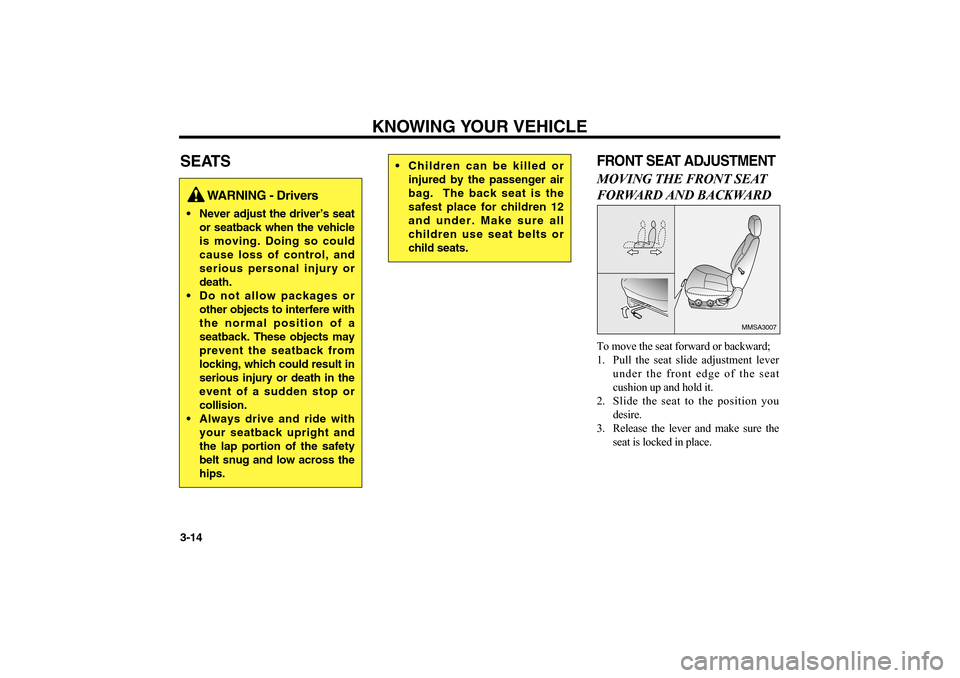
SEATS
FRONT SEAT ADJUSTMENTMOVING THE FRONT SEAT
FORWARD AND BACKWARDTo move the seat forward or backward;
1. Pull the seat slide adjustment lever
under the front edge of the seat
cushion up and hold it.
2. Slide the seat to the position you
desire.
3. Release the lever and make sure the
seat is locked in place.
KNOWING YOUR VEHICLE
3-14
MMSA3007
WARNING - Drivers
Never adjust the driver’s seat
or seatback when the vehicle
is moving. Doing so could
cause loss of control, and
serious personal injury or
death.
Do not allow packages or
other objects to interfere with
the normal position of a
seatback. These objects may
prevent the seatback from
locking, which could result in
serious injury or death in the
event of a sudden stop or
collision.
Always drive and ride with
your seatback upright and
the lap portion of the safety
belt snug and low across the
hips.
Children can be killed or
injured by the passenger air
bag. The back seat is the
safest place for children 12
and under. Make sure all
children use seat belts or
child seats.
MS-CNA-Eng 3.QXD 7/25/2005 5:17 PM Page 14
Page 24 of 225
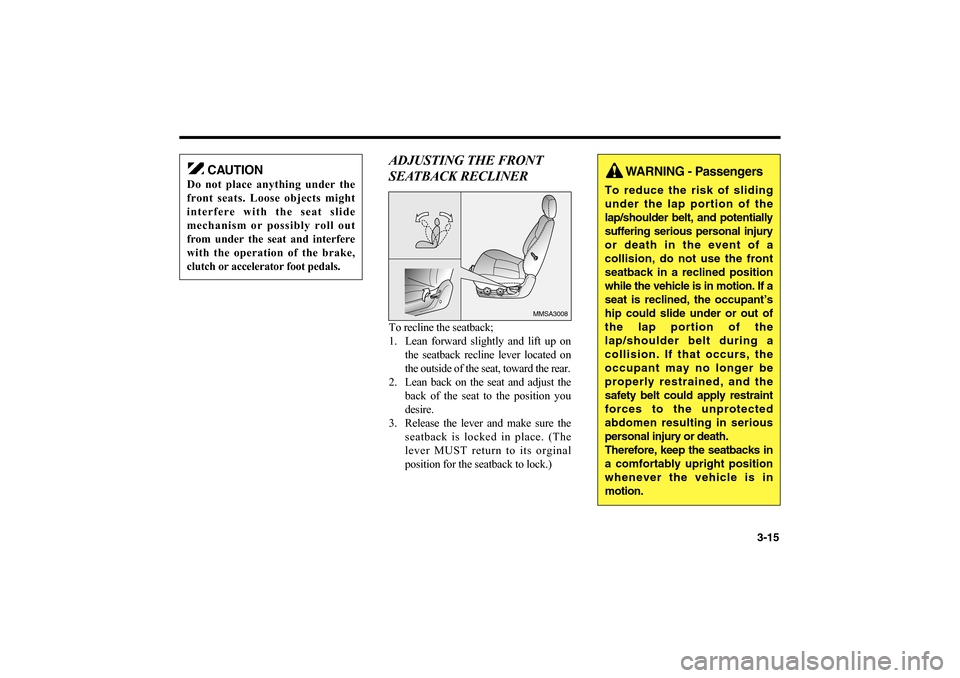
ADJUSTING THE FRONT
SEATBACK RECLINERTo recline the seatback;
1. Lean forward slightly and lift up on
the seatback recline lever located on
the outside of the seat, toward the rear.
2. Lean back on the seat and adjust the
back of the seat to the position you
desire.
3. Release the lever and make sure the
seatback is locked in place. (The
lever MUST return to its orginal
position for the seatback to lock.)
3-15
MMSA3008
CAUTION
Do not place anything under the
front seats. Loose objects might
interfere with the seat slide
mechanism or possibly roll out
from under the seat and interfere
with the operation of the brake,
clutch or accelerator foot pedals.
WARNING - Passengers
To reduce the risk of sliding
under the lap portion of the
lap/shoulder belt, and potentially
suffering serious personal injury
or death in the event of a
collision, do not use the front
seatback in a reclined position
while the vehicle is in motion. If a
seat is reclined, the occupant’s
hip could slide under or out of
the lap portion of the
lap/shoulder belt during a
collision. If that occurs, the
occupant may no longer be
properly restrained, and the
safety belt could apply restraint
forces to the unprotected
abdomen resulting in serious
personal injury or death.
Therefore, keep the seatbacks in
a comfortably upright position
whenever the vehicle is in
motion.
MS-CNA-Eng 3.QXD 7/25/2005 5:17 PM Page 15
Page 28 of 225

3-19
HEATING THE FRONT
SEATS (IF EQUIPPED)The front seats are electrically heated
when the ignition switch is ON and the
corresponding heater switch, shown in
the illustration, is depressed. When
depressed, a thermostat regulates seat
temperature individually. To deactivate
the front seat heating system, depress the
corresponding heater switch again.
ADJUSTABLE HEADREST
(IF EQUIPPED)To raise the headrest, simply pull it up to
the desired position. To lower the
headrest, press the release lever on the
left side grommet, while pushing the
headrest down to the desired position. To
remove the headrest, raise it as far as it
can go then press the release lever while
pulling upward.The headrest may be adjusted forward to
three positions by pulling if forward. To
adjust the headrest backwards, pull it
forward and release it.(If equipped)
MMSA3079
MMSA3016
Release lever
WARNING - Headrests
To reduce the risk of head
and neck injuries, do not
operate the vehicle with the
headrest removed or
improperly posi-tioned.
Do not attempt to adjust the
headrest while driving.
Adjust the top of the headrest
so that it is even with the top
of your ears in order to
reduce the chance of injury in
the event of a collision.
MS-CNA-Eng 3.QXD 7/25/2005 5:17 PM Page 19
Page 30 of 225
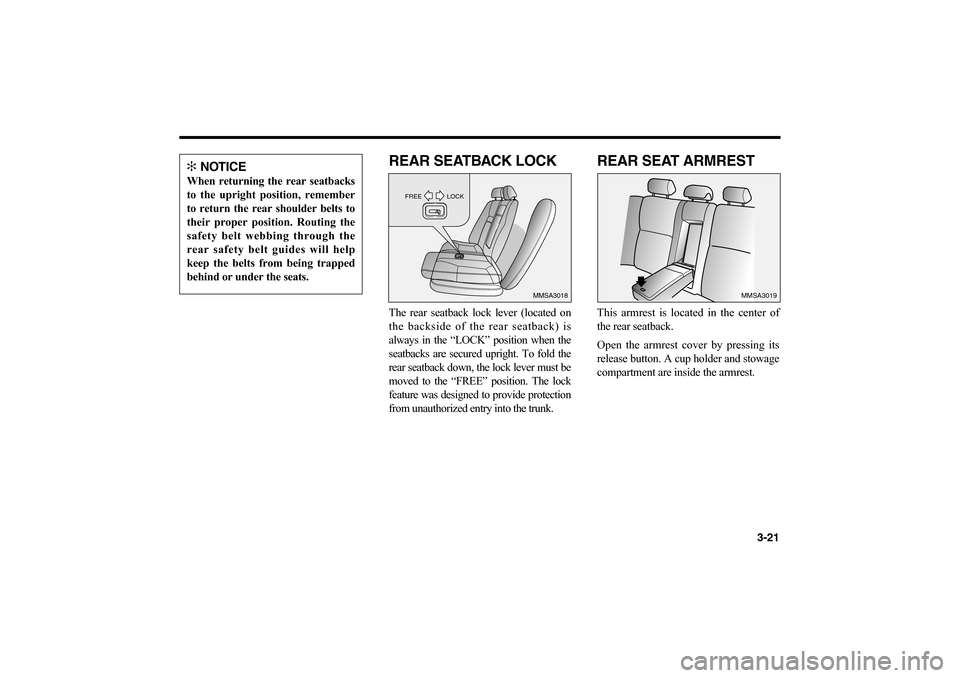
3-21
REAR SEATBACK LOCKThe rear seatback lock lever (located on
the backside of the rear seatback) is
always in the “LOCK” position when the
seatbacks are secured upright. To fold the
rear seatback down, the lock lever must be
moved to the “FREE” position. The lock
feature was designed to provide protection
from unauthorized entry into the trunk.
REAR SEAT ARMRESTThis armrest is located in the center of
the rear seatback.
Open the armrest cover by pressing its
release button. A cup holder and stowage
compartment are inside the armrest.
FREE LOCK
MMSA3018
MMSA3019
✻
NOTICE
When returning the rear seatbacks
to the upright position, remember
to return the rear shoulder belts to
their proper position. Routing the
safety belt webbing through the
rear safety belt guides will help
keep the belts from being trapped
behind or under the seats.
MS-CNA-Eng 3.QXD 7/25/2005 5:17 PM Page 21
Page 34 of 225
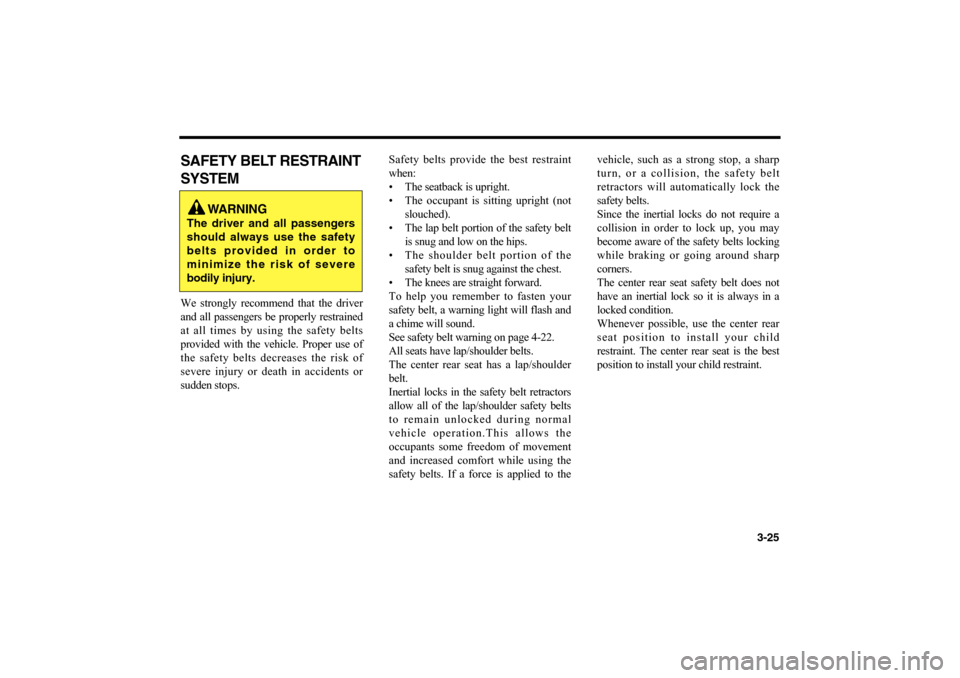
SAFETY BELT RESTRAINT
SYSTEMWe strongly recommend that the driver
and all passengers be properly restrained
at all times by using the safety belts
provided with the vehicle. Proper use of
the safety belts decreases the risk of
severe injury or death in accidents or
sudden stops.Safety belts provide the best restraint
when:
• The seatback is upright.
• The occupant is sitting upright (not
slouched).
• The lap belt portion of the safety belt
is snug and low on the hips.
• The shoulder belt portion of the
safety belt is snug against the chest.
• The knees are straight forward.
To help you remember to fasten your
safety belt, a warning light will flash and
a chime will sound.
See safety belt warning on page 4-22.
All seats have lap/shoulder belts.
The center rear seat has a lap/shoulder
belt.
Inertial locks in the safety belt retractors
allow all of the lap/shoulder safety belts
to remain unlocked during normal
vehicle operation.This allows the
occupants some freedom of movement
and increased comfort while using the
safety belts. If a force is applied to thevehicle, such as a strong stop, a sharp
turn, or a collision, the safety belt
retractors will automatically lock the
safety belts.
Since the inertial locks do not require a
collision in order to lock up, you may
become aware of the safety belts locking
while braking or going around sharp
corners.
The center rear seat safety belt does not
have an inertial lock so it is always in a
locked condition.
Whenever possible, use the center rear
seat position to install your child
restraint. The center rear seat is the best
position to install your child restraint.
3-25
WARNING
The driver and all passengers
should always use the safety
belts provided in order to
minimize the risk of severe
bodily injury.
MS-CNA-Eng 3.QXD 7/25/2005 5:17 PM Page 25
Page 36 of 225
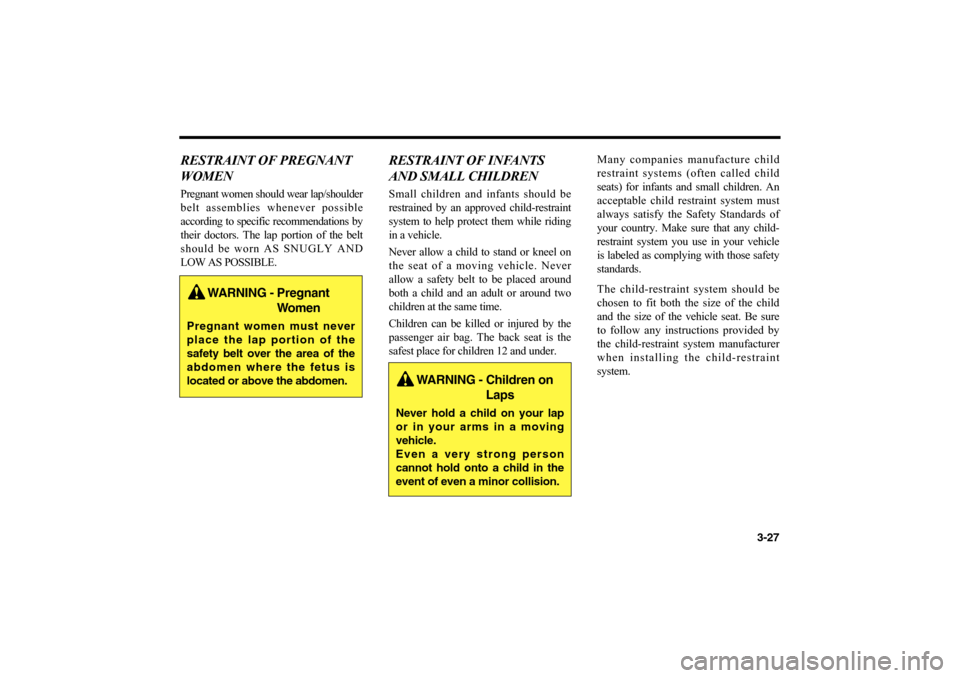
3-27
RESTRAINT OF PREGNANT
WOMENPregnant women should wear lap/shoulder
belt assemblies whenever possible
according to specific recommendations by
their doctors. The lap portion of the belt
should be worn AS SNUGLY AND
LOW AS POSSIBLE.
RESTRAINT OF INFANTS
AND SMALL CHILDRENSmall children and infants should be
restrained by an approved child-restraint
system to help protect them while riding
in a vehicle.
Never allow a child to stand or kneel on
the seat of a moving vehicle. Never
allow a safety belt to be placed around
both a child and an adult or around two
children at the same time.
Children can be killed or injured by the
passenger air bag. The back seat is the
safest place for children 12 and under.Many companies manufacture child
restraint systems (often called child
seats) for infants and small children. An
acceptable child restraint system must
always satisfy the Safety Standards of
your country. Make sure that any child-
restraint system you use in your vehicle
is labeled as complying with those safety
standards.
The child-restraint system should be
chosen to fit both the size of the child
and the size of the vehicle seat. Be sure
to follow any instructions provided by
the child-restraint system manufacturer
when installing the child-restraint
system.
WARNING - Pregnant
Women
Pregnant women must never
place the lap portion of the
safety belt over the area of the
abdomen where the fetus is
located or above the abdomen.
WARNING - Children on
Laps
Never hold a child on your lap
or in your arms in a moving
vehicle.
Even a very strong person
cannot hold onto a child in the
event of even a minor collision.
MS-CNA-Eng 3.QXD 7/25/2005 5:17 PM Page 27
Page 37 of 225
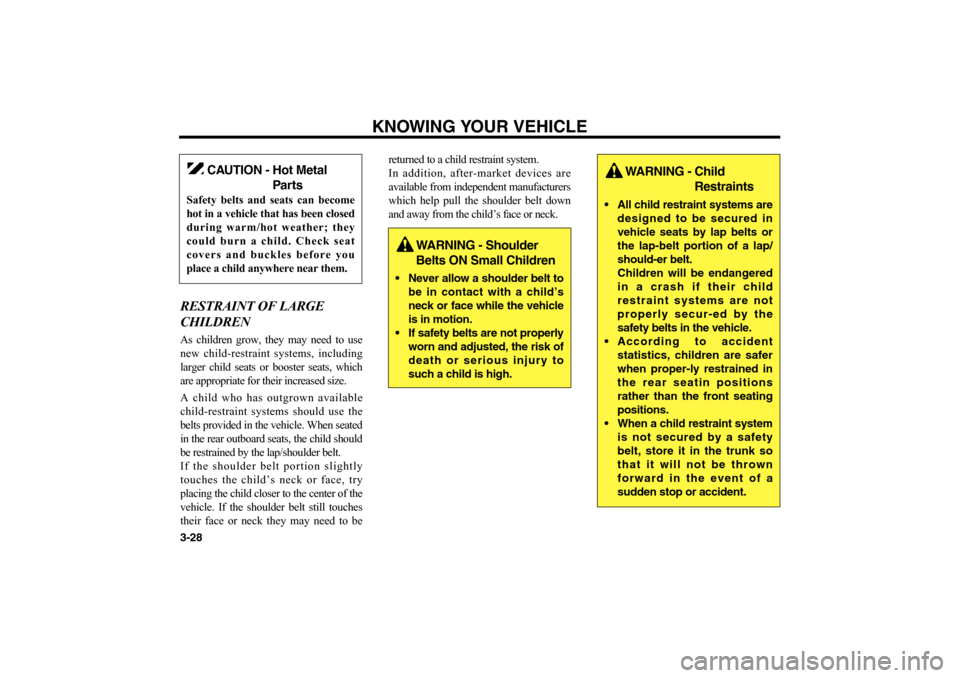
KNOWING YOUR VEHICLE
3-28RESTRAINT OF LARGE
CHILDRENAs children grow, they may need to use
new child-restraint systems, including
larger child seats or booster seats, which
are appropriate for their increased size.
A child who has outgrown available
child-restraint systems should use the
belts provided in the vehicle. When seated
in the rear outboard seats, the child should
be restrained by the lap/shoulder belt.
If the shoulder belt portion slightly
touches the child’s neck or face, try
placing the child closer to the center of the
vehicle. If the shoulder belt still touches
their face or neck they may need to bereturned to a child restraint system.
In addition, after-market devices are
available from independent manufacturers
which help pull the shoulder belt down
and away from the child’s face or neck.
CAUTION - Hot Metal
Parts
Safety belts and seats can become
hot in a vehicle that has been closed
during warm/hot weather; they
could burn a child. Check seat
covers and buckles before you
place a child anywhere near them.
WARNING - Shoulder
Belts ON Small Children
Never allow a shoulder belt to
be in contact with a child’s
neck or face while the vehicle
is in motion.
If safety belts are not properly
worn and adjusted, the risk of
death or serious injury to
such a child is high.
WARNING - Child
Restraints
All child restraint systems are
designed to be secured in
vehicle seats by lap belts or
the lap-belt portion of a lap/
should-er belt.
Children will be endangered
in a crash if their child
restraint systems are not
properly secur-ed by the
safety belts in the vehicle.
According to accident
statistics, children are safer
when proper-ly restrained in
the rear seatin positions
rather than the front seating
positions.
When a child restraint system
is not secured by a safety
belt, store it in the trunk so
that it will not be thrown
forward in the event of a
sudden stop or accident.
MS-CNA-Eng 3.QXD 7/25/2005 5:17 PM Page 28
Page 39 of 225
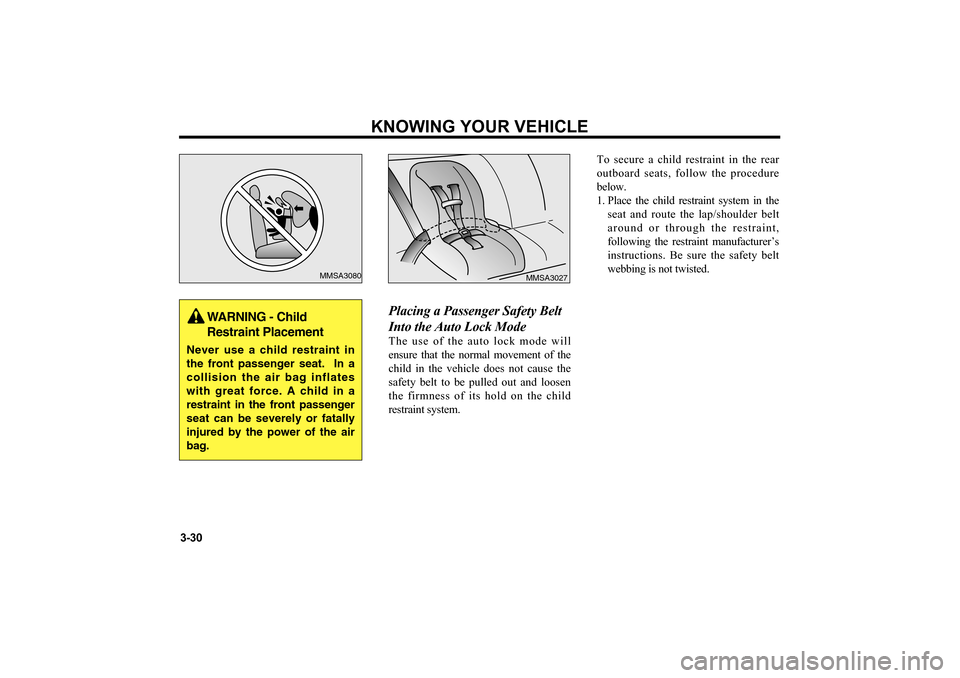
Placing a Passenger Safety Belt
Into the Auto Lock ModeThe use of the auto lock mode will
ensure that the normal movement of the
child in the vehicle does not cause the
safety belt to be pulled out and loosen
the firmness of its hold on the child
restraint system.To secure a child restraint in the rear
outboard seats, follow the procedure
below.
1. Place the child restraint system in the
seat and route the lap/shoulder belt
around or through the restraint,
following the restraint manufacturer’s
instructions. Be sure the safety belt
webbing is not twisted.
KNOWING YOUR VEHICLE
3-30
MMSA3080
MMSA3027
WARNING - Child
Restraint Placement
Never use a child restraint in
the front passenger seat. In a
collision the air bag inflates
with great force. A child in a
restraint in the front passenger
seat can be severely or fatally
injured by the power of the air
bag.
MS-CNA-Eng 3.QXD 7/25/2005 5:17 PM Page 30
Page 44 of 225
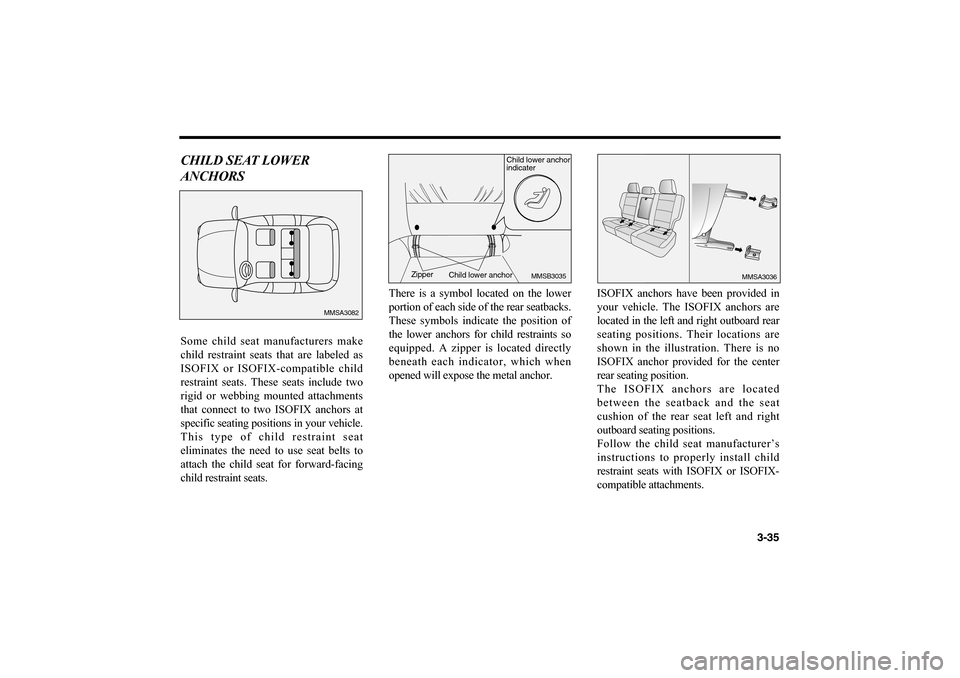
3-35
CHILD SEAT LOWER
ANCHORSSome child seat manufacturers make
child restraint seats that are labeled as
ISOFIX or ISOFIX-compatible child
restraint seats. These seats include two
rigid or webbing mounted attachments
that connect to two ISOFIX anchors at
specific seating positions in your vehicle.
This type of child restraint seat
eliminates the need to use seat belts to
attach the child seat for forward-facing
child restraint seats.There is a symbol located on the lower
portion of each side of the rear seatbacks.
These symbols indicate the position of
the lower anchors for child restraints so
equipped. A zipper is located directly
beneath each indicator, which when
opened will expose the metal anchor.ISOFIX anchors have been provided in
your vehicle. The ISOFIX anchors are
located in the left and right outboard rear
seating positions. Their locations are
shown in the illustration. There is no
ISOFIX anchor provided for the center
rear seating position.
The ISOFIX anchors are located
between the seatback and the seat
cushion of the rear seat left and right
outboard seating positions.
Follow the child seat manufacturer’s
instructions to properly install child
restraint seats with ISOFIX or ISOFIX-
compatible attachments.
MMSA3082
MMSA3036
Child lower anchorChild lower anchor
indicater
Zipper
MMSB3035
MS-CNA-Eng 3.QXD 7/25/2005 5:17 PM Page 35